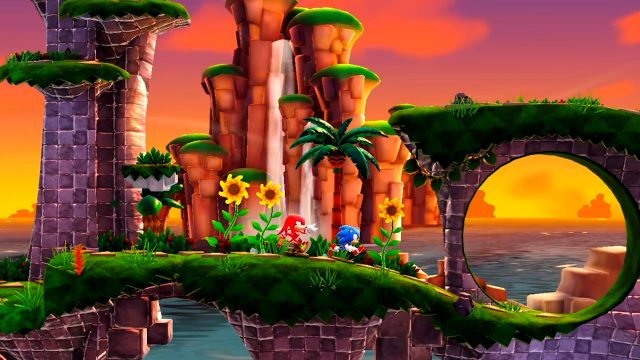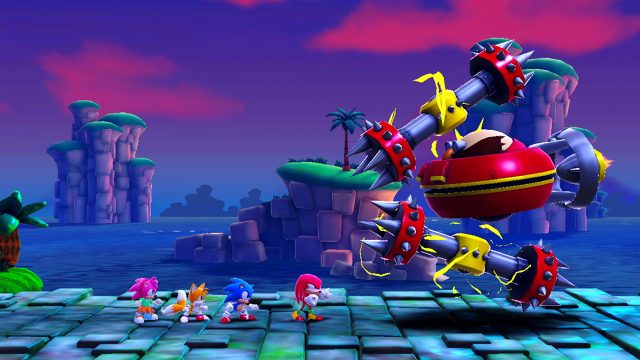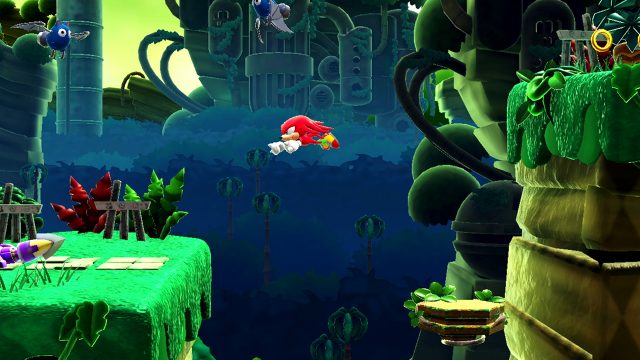Excellent presentation; Gameplay perfectly evokes the feel of classic 2D Sonic while propelling the series forward; New Zones are a visual treat
Multiplayer is too chaotic unless players are all moving in unison; Battle Mode is so vanilla as to be superfluous; Soundtrack is too safe, although there are standout tracks
When it comes to Sonic the Hedgehog, SEGA seems to always find a way to get close to perfection but ultimately miss the mark. I felt that way when playing Sonic Frontiers and I feel that way now playing Sonic Superstars. Superstars is the first new 2D Sonic game to incorporate 3D graphics since Sonic the Hedgehog 4 launched as a pair of episodes between 2010 and 2012. Lambasted by many, Sonic 4 brought the visuals forward but failed to capture the feel of its 2D forbearers. This time around, SEGA has opted to partner with developer Arzest (which is helmed by Sonic and Eggman character designer Naoto Ohshima) to produce a proper 2D adventure starring the Blue Blur. And as I noted above, the game is great, but held back by a handful of small frustrations.
First off, if you’re wondering how Arzest was able to successfully recreate the feel of classic 2D Sonic games, you can thank the physics engine that powered Sonic Mania. It rests at the heart of Superstars and ensures that every character jumps, runs, glides, and hammers exactly like they should. For Superstars, however, SEGA opted to jettison the pixel-based graphics of Mania and install fresh, polygonal visuals to give the game a more updated, modern look. It’s a delightful style that Arzest settled upon. Admittedly, I love pixel art, but Arzest has done a wonderful job evolving the visuals without making the game look hollow and generic. The colors pop, the animations are smooth, and I hope that SEGA keeps this style for future 2D Sonic games.
In terms of story, Dr. Eggman is back as per usual, but this time around he’s partnered with fan-favorite Fang the Hunter (who’s usually paired with Bean and Bark, shoutout to all you Sonic comic fans) and newcomer Trip the Sungazer to explore and exploit the denizens of the Northstar Islands. It’s nothing groundbreaking when it comes to narratives, but it does at least result in Sonic and friends heading off to all-new locales to explore. There are 12 Zones to travel among, and they’re all fairly original and visually engaging. Highlights include the extravagant temple halls of Golden Capital Zone, the trippy digital trickery in Cyber Station Zone, and grinding atop giant vines in Speed Jungle Zone. Every stage offers a menagerie of set pieces and thrilling platforming challenges to enjoy.
The four-player co-op is likely piquing the curiosity of many of you reading this, and I will be frank: I thought it was just okay. On paper, Superstars is similar to Nintendo’s New Super Mario Bros. games, where players can jump into four-player couch co-op and tackle levels together. It’s easy enough to set up, but once the action starts the game begins to have trouble. It’s mainly what I presumed was going to be an issue from the outset, which is that Sonic’s gameplay is simply too fast to accommodate four people playing at once. Unless everyone is managing to move at the same pace, players are inevitably left behind and have to be teleported over to get everyone back on the screen together again.
One way that Arzest tried to mitigate this issue was by putting a bit more focus on platforming over speed in Superstars. Don’t get me wrong, there are some excellent segments, especially in Speed Jungle Zone, where Sonic is blasting across the screen at breakneck speeds. Overall, though, Superstars tries to put the brakes ever so subtly on Sonic’s signature pace and get players doing a lot more platforming than ever before. In execution it doesn’t quite shake out as well as it could. If the multiplayer had been cut entirely, or perhaps limited to just two players at a time (which works much better than three or four), I think Superstars wouldn’t have suffered from it. As it stands, Superstars isn’t as fleet of foot as it could have been without this artificial limitation impressed upon it.
Speaking of multiplayer, Superstars also boasts a Battle Mode and I found it to be very forgettable. Players can customize robotic avatars which they then pit against each other in three-segment face offs. They’re simple affairs (win a race, zap your opponent, etc.) but so inoffensive and bland that I honestly don’t see the appeal. Sonic can collect special coins throughout the campaign which can then be used to unlock new customization options for the bots, but with no real desire to engage with Battle Mode, I quickly stopped caring about seeking them out. Since we’re on the topic of modes, let’s round out this chunk of the review by noting Time Attack is completely fine, offering a chance to scoot through stages as quickly as possible. If you want to really push yourself to the limit and test your skills, Time Attack is where it’s at.
It’s the single-player campaign where Superstars truly shines. It hits all the right notes when it comes to a Sonic game. The stages are in many ways derivative of what fans have seen before, but Arzest has done new and clever things with the gameplay to make even the most vanilla Zone, Bridge Island, feel fresh. Although there aren’t enough of Sonic’s famous loops to my liking, Arzest replaces them with other things like springy vines, midair loops that automatically launch characters on a set path, grinding segments, and much more. There’s even a stage towards the end of the game that puts Sonic into an entirely different genre of gameplay (I won’t spoil it here) and piloting a vehicle I don’t believe he’s ever used before. If I have one gripe, it’s that Sonic seems to slow down as he enters into a loop while on foot. I swapped back and forth between Superstars, Mania, and Sonic Origins just to make sure I wasn’t imagining things. I’m not sure what happens, but Sonic’s momentum often takes a hit right at the climb into a loop, which slows the action.
An area of the single-player that didn’t do much for me was the inclusion of emerald Powers. Chaos Emeralds, as is typically the case, can be located throughout the game, but this time around they unlock special abilities. With each emerald unlocked, players gain access to powers like Bullet, where Sonic can be launched as a fireball, and Vision, where unseen items can be automatically pulled towards the player and collected. They’re… fine, but completely optional and, thus, wholly dispensable. I went the entire playthrough of the campaign never using them, and didn’t even really remember them until stepping into multiplayer with my friends when they asked what the Emerald Powers could do. These abilities aren’t a detraction from the main game, but it’s a shame they didn’t feel more essential. Had Arzest incorporated them into the gameplay in a more meaningful way, like the Wisp-granted Color Powers in Sonic Colors, it could have been a highlight of Superstars.
Before we wrap, I would also like to touch on the soundtrack. Jun Senoue is the music director here, who worked with internal musicians at SEGA as well as Tee Lopes, who handled the soundtrack for Mania. To be fair, the music is serviceable, but it definitely falls short of the heights of Mania or any of the other classic soundtracks the series is known for, like Sonic CD. It’s clear SEGA was trying to mimic the sound of the earlier Sonic games, but the tracks in Superstars lack the energy, vibrance, and complexity of Sonic’s best songs. When Tee Lopes steps in, however, the music is notably better (I would be surprised if Lopes didn’t handle the Speed Jungle tunes). Regardless, while I might feel that the music in Superstars is too safe, that doesn’t mean it’s bad by any stretch of the imagination.
Superstars is exactly what fans have been wanting to see from a modernized 2D Sonic game. It plays like the originals, but is expanded upon with new mechanics and gimmicks. Graphically, Superstars is a stunner. It takes a hit running on Switch compared to other platforms, but performance is rock-solid, always locked in at 60FPS. Although some of the ancillary modes are rather bland, like Battle Mode, or clunky, like co-op, the single player experience is the (pardon the pun) real star of this game. With four playable characters to choose from, there’s plenty of replay value to be found in Superstars, as fans will want to hop back into stages and explore using the characters’ different abilities. Launching right ahead of Super Mario Bros. Wonder, 2023 feels not unlike the glory days of SNES versus Genesis, except now you don’t have to pick a side in the console wars; go give Superstars a purchase, it’s a must-have.
Nintendojo was provided a copy of this game for review by a third party, though that does not affect our recommendation. For every review, Nintendojo uses a standard criteria.




 ShareThis
ShareThis








